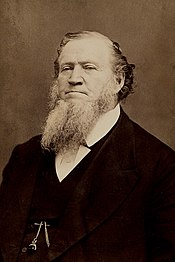(Utah)
From Wikipedia, the free encyclopedia
| Pioneer Day | |
|---|---|

Re-enactment of Mormon pioneers in the 1912 Pioneer Day Parade at Liberty Park, Salt Lake City, Utah
| |
| Observed by | Utah, United States |
| Significance | commemorates the entry of Brigham Young and the first group of Mormon pioneers into the Salt Lake Valley on July 24, 1847 |
| Celebrations | parades, fireworks, rodeos, and other festivities |
| Date | July 24 |
| Next time | July 24, 2016 |
| Frequency | annual |
Pioneer Day is an official holiday celebrated on July 24 in the U.S. state of Utah,[1] with some celebrations in regions of surrounding states originally settled by Mormon pioneers.[2][3] It commemorates the entry of Brigham Young and the first group of Mormon pioneers into the Salt Lake Valley on July 24, 1847,[4] where the Latter-day Saints settled after being forced from Nauvoo, Illinois,[5] and other locations in the eastern United States.[6] Parades, fireworks,rodeos, and other festivities help commemorate the event. Similar to July 4, most governmental offices[1] and many businesses are closed on Pioneer Day.[7]
In addition to being an official holiday in Utah, Pioneer Day is considered a special occasion by many members of The Church of Jesus Christ of Latter-day Saints (LDS Church).[8][9] On Pioneer Day, some Latter-day Saints walk portions of the Mormon Trail or reenact entering the Salt Lake Valley by handcart.[10] Latter-day Saints throughout the United States[11][12] and around the world may celebrate July 24 in remembrance of the LDS Church's pioneer era, with songs, dances, potlucks, and pioneer related activities.[13][14]
While the holiday has strong links to the LDS Church, it is officially a celebration of everyone, regardless of faith and nationality, who emigrated to the Salt Lake Valley during the pioneer era, which is generally considered to have ended with the 1869 arrival of the transcontinental railroad.[15] Notable non-LDSAmerican pioneers from this period include Episcopal Bishop Daniel S. Tuttle, who was responsible for Utah's first non-Mormon schools (Rowland Hall-St. Mark's) and first public hospital (St. Mark's) in the late 1800s.[16] The Intertribal Powwow at Liberty Park in Salt Lake City honors the rich cultural heritage and contributions of the area's Native Americans, helping Utahns to gain a deeper understanding of the region's history.[17][18]
History[edit]
The earliest precursor to Pioneer Day celebrations in Utah occurred on July 24, 1849,[19] when the Nauvoo Brass Band led a commemoration of the second anniversary of the Latter-day Saints entering the Salt Lake Valley.[20]
The first celebration of Pioneer Day in 1857 was interrupted with news of the approach of Johnston's Army, heralding the beginning of the Utah War.[21]During the following occupation of the Utah Territory by federal troops, Pioneer Day was not celebrated.[22] Once President Abraham Lincoln initiated a hands-off policy on Utah in 1862 during the American Civil War[23] Pioneer Day was once again observed, and expanded into the surrounding areas as theMormon Corridor spread throughout the Intermountain West.[22] In 1880, Latter-day Saints commemorated the Golden Jubilee of the church's formal organization in 1830; tens of thousands of people in hundreds of communities participated in very enthusiastic festivities.[22]
In the years that followed, federal enforcement efforts of anti-polygamy laws (including the 1882 Edmunds Act) resulted in greatly subdued celebrations.[22] The 1886 commemoration was particularly notable for itsmourning theme, with the Salt Lake Tabernacle decorated in black instead of the usually colorful bunting, and the eulogizing of Latter-day Saints who were in hiding or imprisoned for polygamy offenses.[22] By 1897, the celebration included not only the 50th anniversary of the initial arrival in the Salt Lake Valley, but also the end of the polygamy issue, the completion of the Salt Lake Temple, and statehood for Utah.[22]
The centennial in 1947 and the sesquicentennial in 1997 were especially large celebrations in Utah. One writer indicated that the 1947 celebrations seemed to incorporate the entire year, with July 24 only being an apex to the events.[24]
 |
| President Brigham Young |


No comments:
Post a Comment